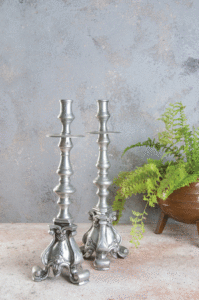Pewter can be seen in the use of candlestick making, small desk objects, bowls and vessels, among other uses.
It is a molten metal, mixed, fired and poured to produce an artistic result. 
Pewter has a long history, dating back to China and beyond.
Pewter is a tin alloy, mixed with metals that contain more than 50-percent tin.
Fine pewter, the kind that collectors adore, and older, antique pieces of pewter, contain around 95-percent tin, with the remaider comprising metals such as bismuth, copper and other fillers.
Many people have concerns that pewter contains lead.
Very old pieces do indeed contain lead, and in historical pieces, one can find 2 percent or more lead bodies in the composite of a piece.
Modern pewter pieces that are manufactured today contain no lead and are worry free in the lead arena.
The history of pewter is not a clear path, but some of the earliest pieces found were unearthed in China and date back some 2000 years ago.
Egyptian archeological sites also have uncovered pewter, and some of the pieces date back to 3500 B.C.
Some people dispute that the earliest piece of pewter was found in Egypt in a tomb, dating back to ancient times.
Many ancient pewter objects were found in Britian, and it is no wonder, as the Romans, when the occupation of what is current, modern day England took place, the Romans brought there pewter with them when occupying and concuring territories all over Europe.
They also secured new sources of tin, with lead mines they used in Cornwall, the richest source of copper and lead at the time, anywhere in the world. During the Middle Ages and Renaissance, pewter was England’s major expert, second only to the textile industry, namely wool.
The rich abundance of earth’s natural resources utilized by craftsman led to the mass exports of handmade goods.
Many people know pewter for an object called a tankard, which is a lidless vessel used for drinking.
Images of castles and courts drinking wine out of pewter are conjured when someone mentions tankards or pewter of antiquity.
By the late 1300s, pewter plates and utensils were used commonly by churches and the nobles of Europe, namely France and England.
Durable, break-resistance and ease of materials led to many objects being manufactured for use in these medieval times.
It is said that Edward I of England had well over 350 pieces of pewter, including platters, dishes and vessels.
In London, around 1348, there was an order called the “Worshipful Company of Pewterers,” formed under the reign of Edward III, which regulated quality of pewter produced by craftsmen.
The work was inspected and had to fall under certain standards for the nobility and church heirarchy to purchase goods from the craft of pewtersmiths.
Pewter reached its peak in the 1600s and early 1700s with master pewterers manufacturing goods all over Europe, Brussels, Nurember, London and New York.
Many people collect American Colonial pewter, known for these high quality standards and regulations.
As materials and products were researched and manufactured, in a constant need to save money, materials and time, as well as need and use, pewter lost popularity in the 18th century, as porcelain tableware, an export, initially, from China, grew in popularity and replaced pewter as a presence on the table and in churches.
In addition, during the Victorian age, ESPN, or electroplating of silver came into vogue, and was much less expensive to manufacture than the craft of pewterers, and thus, the end of an era of pewter making came into being.
Antique collectors can still collect high quality pewter, even after the Victorian age, due to fine quality pewter pieces being made for craftsmanship, rather than necessity, during the Arts and Crafts and Art Nouveau period.
Pewter is still used today by modern pewterers and craftsman that like the versatility and metal content of the metal that was once used by kings, and was the choice of Romans, traveling and conquering a brave new world.
(Editor’s note: DeeDee Wood is the owner of Black Cat Curiosities Art and Antiques in Easton, Md., located at 24B Harrison St.)



